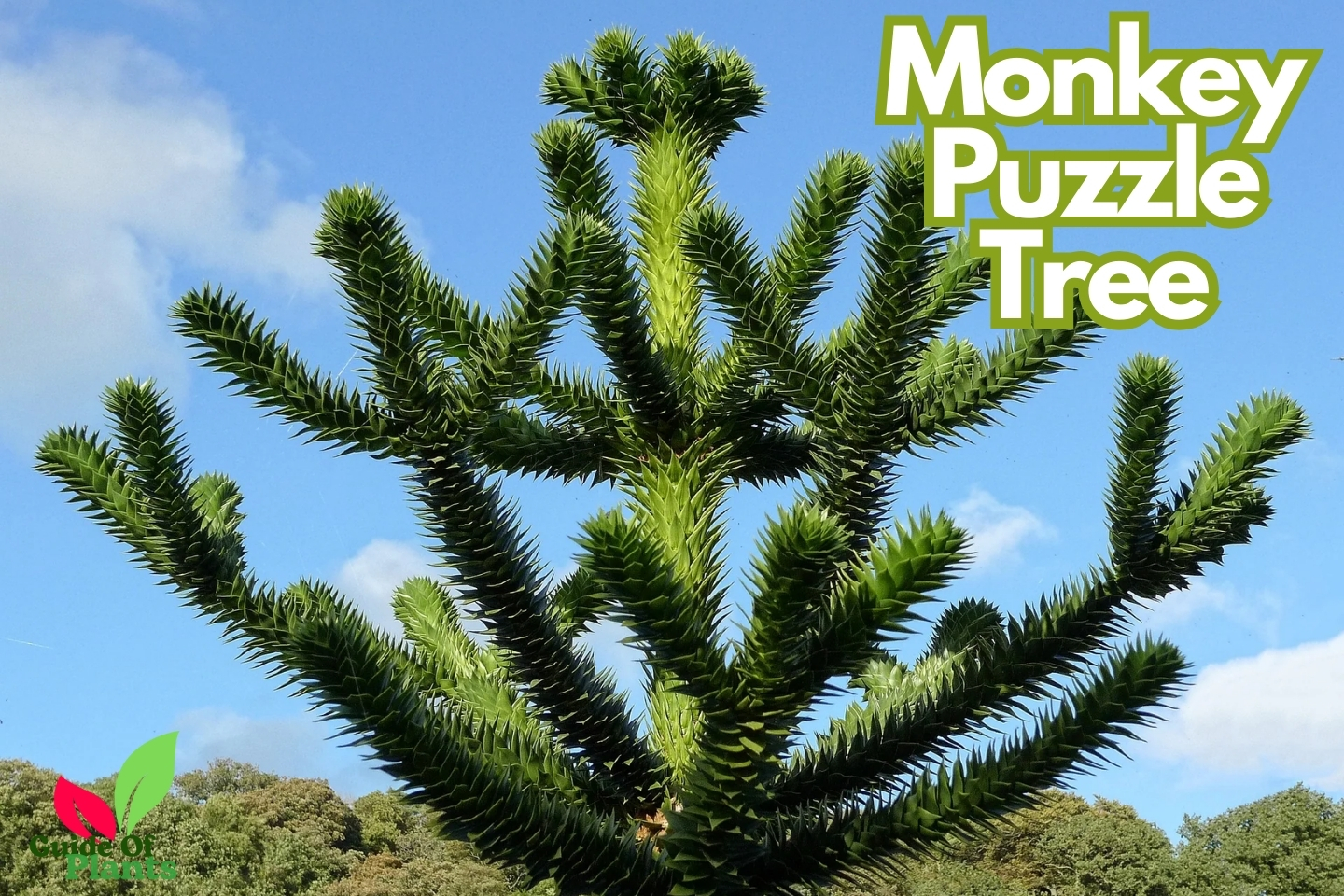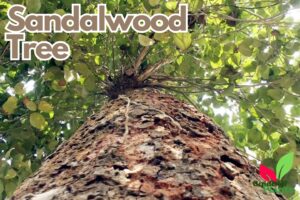The Monkey Puzzle Tree, a living fossil with an intriguing history, has captured the interest of botanists and nature enthusiasts for its distinct characteristics and remarkable conservation story. This unique tree has some captivating qualities that make it stand out in the plant kingdom.
Table of Contents
Also Know About
- Dragon’s Blood Tree The Nature’s Wonder
- The Silk Floss Tree, Nature’s Remarkable Gift To Life
- The Strangler Fig Plant A Wonderful Creation Nature
- Nepenthes Alata, Nature’s Old Secrets of The Carnivorous Adaptation
- Discover The 3 Main Types of Forest Trees You Must Know
Botanical Description
The Monkey Puzzle Tree has a very distinctive physical appearance, with spiky, durable leaves arranged in symmetrical spirals along its branches. Its scientific name, Araucaria araucana, derives from the Mapuche Indian language, reflecting this tree’s native origins in central and southern Chile and western Argentina. The leaves are thick, sharply pointed, and overlap each other in multiple sets of seven. The branches emerge from the trunk in whorls, giving the tree a very structured, uniform shape.

Facts About Monkey Puzzle Tree
The monkey puzzle tree has an ancient lineage, dating back to the time of dinosaurs over 200 million years ago. This intriguing tree belongs to the primitive family of Araucariaceae, which originated during the Jurassic period. Fossil records indicate this family was widespread during prehistoric times. Today, the monkey tree is considered a living fossil.
Some fascinating facts about the monkey tree:
- Its puzzles monkey-like climbers with its prickly, entangled branches.
- Individual trees can live over 1,000 years.
- The female trees produce large, egg-shaped cones containing over 200 edible seeds.
- The monkey tree is the national tree of Chile.
- This hardy tree can withstand cold temperatures and drought.
- Monkey puzzle wood is highly prized for its beauty and durability.
The Araucaria araucana is truly a unique botanical wonder. This primordial tree has stumped botanists for centuries with its unusual leaves, branches, and longevity. As a living fossil, it provides a glimpse into the distant past when dinosaurs still roamed the Earth. This distinctive evergreen continues to captivate people today with its ancient, intriguing history and one-of-a-kind appearance.
How to Grow a Monkey Puzzle Tree
The monkey puzzle tree is an intriguing prehistoric specimen that can make for an exotic addition to gardens and landscapes. While challenging to cultivate, Araucaria araucana can thrive if given proper care and growing conditions. Here is a comprehensive guide to successfully raising this unique living fossil.

Selecting a Monkey Puzzle Tree Seedling
Acquiring a healthy, vigorous Araucaria araucanae seedling is the critical first step to successfully establishing this unique specimen in your landscape. Here are some tips for choosing an ideal seedling:
- Seek out a reputable nursery or specialty grower that propagates monkey trees from seed. This species does not grow true from cuttings. Quality nurseries will sprout seeds and grow seedlings in optimal controlled conditions for 1-2 years before sale.
- Inspect the stem and root system thoroughly. Look for a sturdy trunk that stands upright without support. Check that the roots are well-developed but not excessively pot-bound. Avoid any seedlings with damage, lesions, or signs of disease.
- Examine the foliage. Choose a seedling with full, green needles without yellowing or browning. Needles should be arranged in tidy spirals along the stem rather than appearing unkempt.
- Opt for a small plant 12-18 inches tall in a 1-2 gallon pot. This younger age range establishes more readily when transplanted. Older seedlings tend to struggle with transplant shock.
- Time your purchase for early spring after the final frost but before new growth has emerged. The period of active growth is ideal for transitioning the seedling with minimal stress.
Selecting a vigorous Araucaria araucana seedling sets the stage for growing a thriving specimen of this ancient endemic Chilean conifer. Take care to start with a healthy plant from a reputable supplier.
Providing the Proper Growing Conditions for Monkey Puzzle Trees
Establishing optimal growing conditions is crucial for the health and development of a young monkey puzzle tree. Here are some key considerations:
- Site in full sun – monkey trees require at least 6 hours of direct, unfiltered sunlight per day. Morning sun is especially important. Insufficient light will result in sparse growth.
- Account for climate – This species thrives in USDA hardiness zones 7-9. They prefer cool, temperate climates with high humidity. Avoid hot, dry areas.
- Prepare the soil – Monkey trees need acidic, nutrient-rich soil with a pH of 5.5-6.5. Incorporate compost or peat moss into heavy clay soils to improve drainage.
- Water thoroughly – Consistent moisture is vital, especially for young trees. Water at least 1-2 inches per week, adjusting for rainfall. Soil should be moist but not waterlogged.
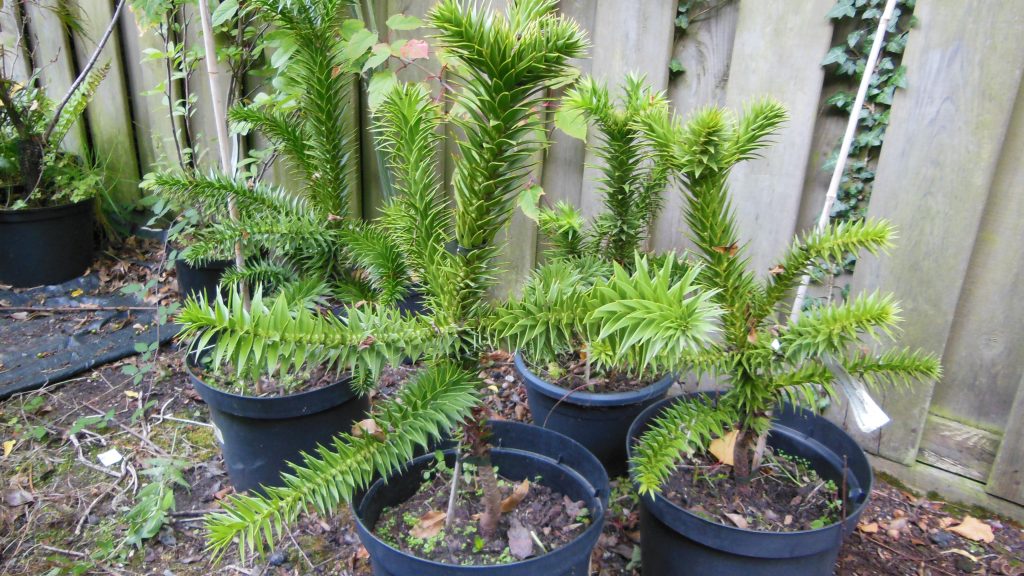
Caring for Young Monkey Puzzle Trees
Caring properly for juvenile monkey puzzle trees gives them the best start:
- Apply 2-4 inches of organic mulch around the tree to conserve moisture and reduce weeds. Avoid contact with the trunk.
- Stake the trunk for the first 1-2 years until well established. Use soft ties to allow some movement.
- Prune only dead or damaged branches to maintain the natural shape. Minimal pruning is required.
- Fertilize in early spring with an organic, balanced product to stimulate healthy new growth.
Following these guidelines provides ideal conditions for robust growth during the critical establishment phase. Proper care in early years helps ensure a long, healthy life.
Ensuring Long-Term Health of Monkey Puzzle Trees
With excellent care and optimal growing conditions, a Araucaria araucana can grow into an impressive, long-lived specimen in the landscape. This prehistoric giant is sure to add majestic, botanical allure.

Monitoring Soil Acidity
The Araucaria araucana requires acidic soil with a pH between 5.5-6.5 to thrive. Test soil pH annually using an at-home kit or professional lab. If the pH creeps higher, amend the soil around the tree’s roots with elemental sulfur or aluminum sulfate to lower acidity. For very alkaline soils, incorporate acidic organic material like pine needles or coffee grounds. Keeping soil pH in the ideal range will maintain proper nutrient availability.
Managing Pests
Aphids, scale, and spider mites may infest monkey puzzle trees. Check foliage regularly for honeydew secretions or visible insects. Using a strong spray of water can dislodge populations. For severe infestations, apply horticultural oil or neem oil per label instructions. This coats and smothers pests while being gentle on beneficial insects. Avoid excess nitrogen fertilization which stimulates growth susceptible to pests.
Protecting Against Winter Damage
The evergreen foliage of monkey puzzle trees can suffer desiccation, browning, and burn over winter. Shield the tree from harsh winds which exacerbate moisture loss. If possible, install burlap wind barriers while avoiding trunk contact. Avoid excessive winter fertilization which spurs late season growth vulnerable to cold damage. Irrigate deeply before the ground freezes to hydrate.
Allowing Ample Growing Space
A mature Araucaria araucana can reach 60 feet tall by 20 feet wide. Select a site with adequate space to accommodate the tree’s substantial size at maturity. Failure to provide sufficient room results in stunted growth and need for excessive pruning. Dwarf cultivars reaching 20-30 feet tall are an option for smaller spaces. Give all trees at least 15-20 feet of clearance from structures, utilities, and other plants.
Proper long-term care ensures monkey trees remain vigorous and resilient for decades, reaching their full majestic potential.
Where it Grows
The monkey puzzle tree is native to the temperate rainforests of central and southern Chile and western Argentina. Its natural habitat is characterized by cool, wet conditions often found at higher altitudes along the Andes Mountains. The tree thrives in areas with high rainfall, humidity, and well-drained volcanic soil. This is why the Araucaria araucana is predominately found at elevations between 800-2000 meters. Its unique adaptation allows it to flourish in the harsh climate of the high Andes.

Common Uses
The monkey tree has been utilized in a variety of ways. Its durable, rot-resistant timber is highly valued for construction, furniture, and shipbuilding. The ornamental qualities of the Araucaria araucana have made it a popular choice for parks, gardens, and landscaping around the world. Its unique silhouette and resilience add aesthetic interest. The female trees produce large, egg-shaped cones which contain edible seeds that can be roasted and eaten or pressed for oil. Historically, the native people of Chile utilized the seeds as a staple food source. The tree also has medicinal properties and has been used to treat various ailments.
Conservation Story
Due to overharvesting for its valuable timber, the Araucaria araucana survival in its native habitat became threatened. Widespread deforestation also destroyed significant portions of the temperate rainforests where it grows. Illegal logging continued due to high demand. Climate change has further stressed populations already struggling to recover. However, increased conservation efforts are now focused on restoring monkey puzzle tree forests in Chile and Argentina. Protected areas have been established specifically for preservation. Reforestation programs utilizing seed banks and nurseries have also been created. Ongoing monitoring and habitat protection are critical for the continued survival of this living fossil.
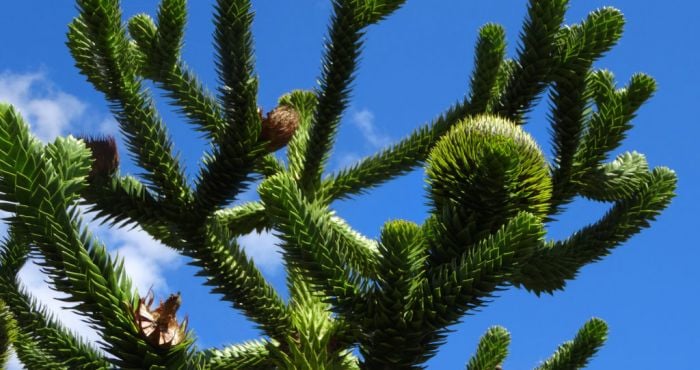
Fun Facts About The Monkey Puzzle Tree
TheAraucaria araucana got its intriguing name from a comment made by William Lobb, a Victorian plant collector. Upon first seeing the tree, he remarked that it would puzzle a monkey to climb. Some other fascinating facts about this unique tree:
- The Araucaria araucana can live up to 1,000 years.
- Fossil records date the monkey tree lineage back 150 million years.
- The pinecones take nearly 3 years to mature and can weigh over 10 pounds.
- The indigenous Araucanian people of Chile used the tree’s large seeds as a food staple.
The Devil and the Monkey Puzzle Tree
According to Chilean folklore, the Araucaria araucana outsmarted the Devil. The legend goes that the Devil decided to climb a monkey tree but got stuck in its densely tangled and spiky branches. He eventually gave up trying to figure out how to get down. In his fury, the Devil cursed the tricky tree, decreeing it would never grow straight, giving it the twisted shape it has today.
Best Conditions for a Monkey Puzzle Tree
The monkey puzzle tree thrives under the following growing conditions:
- Climate: Cool and temperate; ideally hardy to USDA zones 7-9. Prefers high humidity and rainfall. Intolerant of hot, dry summers.
- Soil: Acidic, nutrient-rich, well-draining soil. Volcanic soil is optimal.
- Sun: Full sun for optimal growth, but partial shade is tolerated.
- Water: Regular watering and consistently damp (but not soaked) soil. Drought sensitive.
- Spacing: Allow ample space for growth. Can reach 40-60 ft tall and 20-30 ft wide.
Providing the ideal climate, sunlight, soil, moisture, and space will allow a Araucaria araucana to grow healthy and strong. Proper care will bring out the best characteristics of this unique living fossil.

Why the Monkey Puzzle Tree Should be Conserved
The monkey puzzle tree is a living fossil that provides a direct link to the ancient flora that existed when dinosaurs roamed the Earth over 150 million years ago. As one of the oldest tree species on the planet, it has immense evolutionary importance. The monkey tree also plays a vital ecological role in the temperate rainforests of Chile and Argentina where it naturally occurs. Its tall canopy provides habitat, food sources, and shelter for native wildlife.
The tree’s shade and nutrient-rich leaves on the forest floor are critical for understory plants. Additionally, the Araucaria araucana holds significance in Chilean culture, figuring prominently in folklore, mythology, and poetry. Its image is depicted on Chile’s coat of arms and Chilean currency. Due to overlogging and habitat loss, the tree’s global population has been reduced by over 50% since the early 1900s.
Preserving this rare and iconic tree is crucial before it becomes endangered. More protected wilderness areas should be established in its native range. Reforestation efforts, seed banks, and banning of illegal logging must continue. Education on the Araucaria araucana‘s ecological and cultural importance is also key. With proper conservation measures, future generations can continue to appreciate this ancient living fossil.
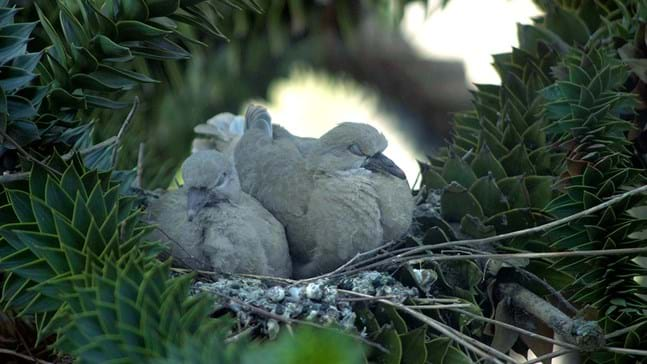
Natural Habitat of the Monkey Puzzle Tree
In its native range along the Andes Mountains, the monkey puzzle tree is found at elevations between 800-2000 meters in Chile’s temperate rainforests. It thrives in areas of high humidity and rainfall exceeding 2,000 mm annually. The tree is well-adapted to cool average temperatures around 7-12°C and fluctuating conditions in mountainous terrain.
Its habitat is characterized by well-drained, acidic, volcanic soil that provides nutrients. The Araucaria araucana is often the emergent species protruding above the canopy of Chile’s dense, moist Valdivian and North Patagonian forests. Various southern beech trees, winter’s bark trees, and Chilean fire bushes typically surround it at lower levels. The monkey tree’s shade and leaf litter on the forest floor facilitate thick underbrush growth.
Its native habitat harbors astounding biodiversity, including rare endemic wildlife like the Chilean puma, Darwin’s fox, southern pudu deer, Magellanic woodpecker, and monito del monte. Preserving intact tracts of Chile’s temperate rainforests is crucial for protecting the Araucaria araucana in its natural ecosystem shared with diverse flora and fauna.

Conclusion
The ancient monkey puzzle tree is truly one of the most unique and fascinating plant species on Earth. As a living fossil dating back to prehistoric times, it provides an astounding link to the primal forests where dinosaurs once dwelled. This primordial tree has confounded scientists and nature enthusiasts for centuries with its unusual appearance and improbable longevity.
The spiky-leaved evergreen has rightfully earned its mythic folklore status. While the Araucaria araucana global population has declined due to deforestation and climate change, focused conservation efforts offer hope for protecting this iconic tree. Its ecological value and cultural symbolism in its native Chile make it a national treasure worth preserving.
Ongoing reforestation initiatives, guarded wilderness sanctuaries, and environmental education can ensure the endurance of the monkey puzzle tree for generations to come. This resilient tree serves as a reminder of our interconnectedness with all living things – even those originating hundreds of millions of years in the distant past. The enduring legacy of the monkey puzzle tree inspires appreciation and stewardship of the natural world.

